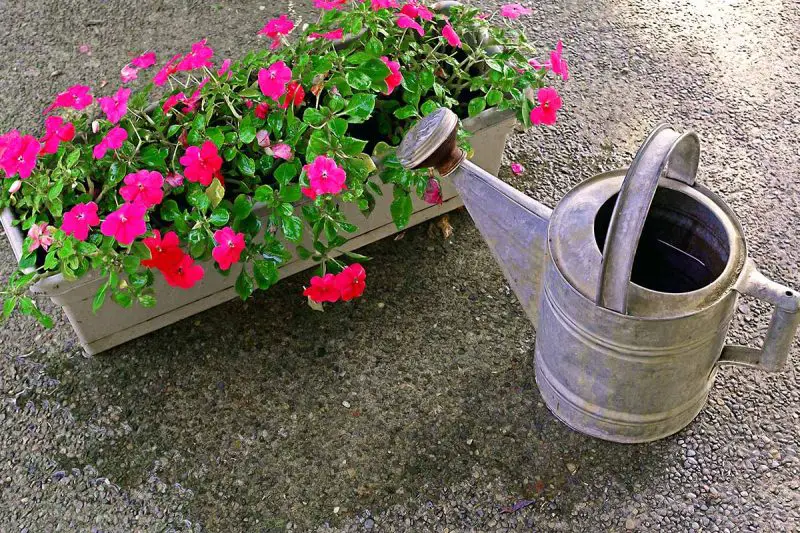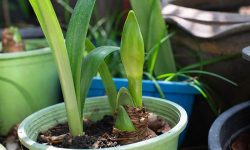Impatiens are popular garden flowers known for their vibrant colors and continuous blooms. Their beauty can transform shaded areas into lively, colorful displays. However, proper watering is crucial to keep these plants healthy. Too little water causes wilting and flower drop, while overwatering can lead to root rot and fungal issues. Gardeners often struggle to find the right balance, as environmental conditions and container versus in-ground planting affect water needs.
Understanding how often to water impatiens ensures stronger stems, fuller blooms, and longer flowering periods. Soil type, temperature, humidity, and sun exposure all influence irrigation schedules. Observing the plants and adjusting watering routines helps maintain optimal moisture without stressing them. Combining careful watering with proper fertilization, mulching, and pest management promotes vigorous growth. This guide explores expert techniques to maintain lush, vibrant impatiens blooms throughout the season, helping gardeners achieve consistent color and health in every garden bed or container.
Understanding Impatiens Water Needs

Impatiens are delicate plants that require consistent moisture for optimal growth. Their roots are shallow, making them highly susceptible to drying out, especially during hot or windy conditions. Both in-ground and container plantings need careful attention. Soil that dries too quickly stresses the plant, causing leaves to wilt and flowers to drop. Conversely, waterlogged soil can suffocate roots and promote fungal diseases, leading to premature plant decline. Understanding the natural water requirements of impatiens helps gardeners maintain vibrant, healthy blooms throughout the season.
Environmental factors heavily influence how often impatiens need water. In shaded areas, evaporation is slower, so plants retain moisture longer, reducing watering frequency. Plants in full or partial sun require more frequent irrigation due to higher evaporation rates and increased transpiration. Temperature fluctuations, wind exposure, and soil type also affect moisture retention. Sandy soils drain quickly and require more frequent watering, while clay soils hold water longer but can become compacted and limit oxygen flow to roots. Adjusting watering schedules based on these conditions ensures impatiens remain healthy and bloom consistently.
Observation is crucial for proper watering. Check soil moisture regularly by inserting a finger about an inch into the soil. If it feels dry, it’s time to water. Monitor plant behavior: drooping leaves, pale foliage, or smaller flowers often indicate insufficient water. Conversely, yellowing leaves, soggy soil, or foul smells suggest overwatering. By understanding the plant’s needs, environmental influences, and signals of stress, gardeners can establish a balanced watering routine. Consistent, thoughtful watering promotes robust growth, enhances flower longevity, and maintains the lush, vibrant appearance that makes impatiens a favorite for gardens and containers alike.
Best Time of Day to Water Impatiens
Watering impatiens at the right time of day greatly influences their health and bloom longevity. Early morning is ideal because it allows the plant to absorb moisture before the heat of the day. Morning watering reduces evaporation, ensuring water reaches the roots efficiently. Providing ample moisture early prevents midday stress and supports strong stems, vibrant foliage, and abundant flowers. This simple timing adjustment can make a noticeable difference in flower quality and overall plant vigor, especially during hot summer months when water demand is highest.
Sun exposure and temperature patterns affect the best watering schedule. In hot, sunny locations, early morning irrigation ensures plants receive water before the sun causes excessive evaporation. For shaded areas, mid-morning or late morning watering can suffice, as these locations retain soil moisture longer. Adjusting watering times to seasonal changes ensures consistent hydration. During heatwaves or dry spells, gardeners may need to water slightly later in the morning while still avoiding late-day irrigation. Evening watering may seem convenient but can leave leaves wet overnight, promoting fungal diseases, mildew, and other moisture-related problems that compromise blooms.
Consistency in timing also promotes stronger root development. Regular morning watering encourages roots to grow deeper and search for moisture, enhancing resilience against drought and heat stress. Paired with proper soil preparation, mulching, and fertilization, watering at the correct time of day ensures impatiens thrive and bloom continuously. Observing how soil and foliage respond to watering helps gardeners fine-tune schedules for maximum effect. Those who follow a consistent routine aligned with natural conditions experience fewer disease problems, healthier plants, and more prolonged, colorful displays, maintaining the lush, vibrant appearance that makes impatiens a favorite for garden beds and containers alike.
Signs Your Impatiens Need Water
Recognizing when impatiens need water is crucial for maintaining vibrant blooms and healthy growth. The most obvious sign is wilting foliage. When leaves droop or curl, it indicates the plant is experiencing water stress. Early detection allows gardeners to act promptly, preventing flower drop and stem damage. Soil moisture levels are also key indicators. Dry soil an inch below the surface signals that the plant requires irrigation, while consistently damp soil may indicate overwatering, which can suffocate roots and reduce bloom quality.
Other visual cues include leaf color and flower condition. Leaves that turn pale or yellow often result from inconsistent watering. Flowers may also fade or drop prematurely when plants do not receive sufficient moisture. Checking container plants is particularly important, as pots can dry out faster than garden beds. In addition, soil type affects how quickly water is lost. Sandy soils dry faster, requiring more frequent watering, whereas clay soils retain water longer, which can sometimes lead to root rot if not monitored. Observing these signals helps maintain the delicate balance impatiens need for continuous blooms.
Behavioral patterns can also indicate water needs. Plants in full sun or windy conditions may require extra hydration even if recent rainfall occurred. Consistent observation allows gardeners to adjust watering schedules according to environmental conditions. Monitoring both the soil and the plant’s response ensures that irrigation meets the plant’s actual requirements, promoting strong stems, lush foliage, and abundant flowers. By recognizing these signs and acting accordingly, gardeners can optimize bloom longevity and maintain a healthy, colorful impatiens display throughout the growing season.
How Soil Type Affects Impatiens Watering
Soil type plays a crucial role in determining how often impatiens need water. Sandy soils drain quickly, causing moisture to evaporate faster. Plants in sandy soil may require more frequent watering to prevent wilting and maintain healthy blooms. Gardeners should monitor soil moisture closely and water when the top inch feels dry. Adding organic matter, such as compost or peat, helps improve water retention while providing essential nutrients, supporting both root health and flower production. Proper soil preparation ensures impatiens receive consistent hydration and sustains vigorous flowering.
Clay soils, in contrast, retain water for longer periods but can become compacted, limiting oxygen availability to roots. Overwatering in clay soil can lead to root rot and fungal infections, which negatively affect bloom longevity. To prevent these issues, gardeners should water deeply but less frequently, allowing the soil to dry slightly between watering sessions. Incorporating coarse sand, perlite, or organic matter improves drainage while maintaining adequate moisture for impatiens. Understanding the soil’s water-holding capacity helps avoid stress and promotes healthy, continuous blooms.
Loamy soils provide the ideal balance for impatiens. They retain enough moisture for consistent hydration while allowing excess water to drain, reducing stress on roots and preventing disease. Mulching loamy soil helps regulate temperature, conserve water, and suppress weeds. Observing plant response to soil conditions allows gardeners to adjust watering schedules effectively. By understanding how different soil types affect water retention, drainage, and root health, gardeners can ensure impatiens receive optimal hydration. This knowledge supports lush foliage, vibrant flowers, and long-lasting garden displays throughout the growing season.
Container vs. In-Ground Impatiens Watering Needs
Container Impatiens Watering
Impatiens grown in containers have different watering requirements than those in the ground. Pots dry out faster, especially in hot, sunny locations or on patios and balconies. Container plants require more frequent monitoring to prevent wilting and flower drop. Water should reach the root zone thoroughly, ensuring the entire soil mass is moist without leaving excess water at the bottom. Proper drainage is essential to avoid root rot, so containers must have sufficient holes and use well-draining potting mix.
Besides drainage, container placement affects watering frequency. Moving pots to partial shade during peak sun hours can reduce evaporation and stress. Mulching the soil surface in containers helps retain moisture and regulate temperature. Fertilization should be adjusted for container-grown plants, as nutrients can leach out with frequent watering. By combining these practices, gardeners can maintain healthy roots and consistent blooms, ensuring container impatiens remain vibrant throughout the growing season. Observing the plant’s needs and adjusting watering accordingly prevents stress and prolongs flowering.
In-Ground Impatiens Watering
In-ground impatiens generally require less frequent watering than container plants due to larger soil volumes that retain moisture longer. However, soil type, sun exposure, and local climate affect irrigation needs. Sandy soils may dry quickly, necessitating additional water, while clay or loamy soils hold moisture longer. Checking soil moisture at the root zone before watering helps avoid over- or under-watering. Deep watering encourages strong root development, making plants more resilient to heat and drought stress.
Mulching in garden beds is highly effective for in-ground impatiens. It conserves soil moisture, regulates temperature, and suppresses weeds, all of which contribute to longer-lasting blooms. Regular observation of plant health, including leaf turgor and flower condition, guides watering decisions. By balancing natural soil retention with supplemental irrigation, gardeners can maintain lush foliage and continuous flowering. Understanding the differences between container and in-ground watering ensures impatiens thrive in any setting, providing colorful, vibrant displays for extended periods.
Adjusting Watering Frequency by Season
Impatiens’ watering needs change with the seasons, as temperature, sunlight, and rainfall patterns directly affect soil moisture. During spring, temperatures are moderate, and soil tends to retain water well. Gardeners should water impatiens when the top inch of soil feels dry, usually every two to three days for in-ground plants. Containers may require more frequent checks. Regular, consistent watering during this period encourages root establishment, early-season blooms, and strong plant growth. Observing how plants respond helps gardeners fine-tune irrigation routines to maintain healthy, vibrant foliage and flowers.
Summer brings higher temperatures, stronger sunlight, and increased evaporation. Impatiens may require more frequent watering to prevent wilting and flower drop. In-ground plants benefit from deep, thorough watering to reach roots and reduce heat stress. Containers, especially those in full sun, may need twice-daily irrigation. Mulching helps retain soil moisture, and partial shade can protect plants from harsh midday sun. Careful observation is crucial, as overwatering in high heat can still lead to root rot, fungal infections, and weakened blooms. Adjusting watering schedules according to heatwaves or dry spells ensures plants remain hydrated and productive.
As autumn approaches, cooler temperatures and natural rainfall reduce irrigation needs. Gardeners should gradually decrease watering frequency, allowing the soil to dry slightly between sessions. This adjustment prevents waterlogging while maintaining moisture for late-season blooms. Monitoring plant health, soil condition, and local weather ensures impatiens thrive until the end of the growing season. By adapting watering practices to seasonal conditions, gardeners promote strong roots, lush foliage, and vibrant flowers, extending color and bloom longevity across spring, summer, and fall, and achieving consistently beautiful garden displays year after year.
Fertilizing Impatiens for Optimal Growth and Bloom
Fertilizing impatiens plays a crucial role in maintaining vibrant flowers and healthy foliage. These plants have high nutrient demands, especially during active growth and blooming periods. Using a balanced, water-soluble fertilizer ensures that plants receive essential nitrogen, phosphorus, and potassium. Nitrogen promotes lush foliage, phosphorus supports strong root development and flower production, while potassium enhances overall plant vigor and disease resistance. Applying fertilizer according to the manufacturer’s recommendations prevents overfeeding, which can damage roots and reduce bloom quality.
Timing and method of fertilization are important for maximizing benefits. Gardeners should begin fertilizing when new growth appears in spring, continuing every two to three weeks throughout the growing season. Fertilizer can be applied directly to the soil or as a foliar spray for faster nutrient absorption. Combining fertilization with regular watering helps nutrients reach the root zone efficiently. Avoid applying fertilizer to dry soil, as it may burn delicate roots and stress the plant. Consistent nutrition ensures impatiens maintain bright flowers and strong stems, enhancing overall garden display.
Monitoring plant response is essential to adjust fertilization practices. Signs of nutrient deficiency include pale or yellowing leaves, weak stems, or reduced flower production. Adjusting fertilizer type, frequency, or concentration can correct deficiencies and support continuous blooming. Pairing proper fertilization with mulching, pest management, and appropriate watering schedules creates optimal growing conditions. By understanding the role of nutrients and applying them thoughtfully, gardeners can enjoy lush, healthy impatiens with vibrant flowers that last longer throughout the season, making their garden beds and containers consistently colorful and attractive.
Mulching to Retain Moisture and Reduce Stress
Mulching is a highly effective practice for maintaining soil moisture and reducing environmental stress on impatiens. A layer of organic mulch, such as shredded bark, compost, or leaf litter, helps retain water in the soil, preventing rapid evaporation during hot or windy conditions. By conserving moisture, mulching reduces the frequency of watering while keeping roots consistently hydrated. This stable environment promotes healthy growth, lush foliage, and continuous flowering throughout the season. Mulch also regulates soil temperature, protecting roots from extreme heat or sudden cold snaps, and creating a more favorable environment for nutrient uptake.
Beyond moisture retention, mulching helps minimize stress caused by external factors. It suppresses weeds that compete with impatiens for water and nutrients, allowing the plants to thrive. Additionally, mulch acts as a buffer against soil erosion, keeping roots secure and preventing nutrient loss during heavy rainfall. Choosing the right type of mulch and maintaining a 2–3 inch layer around the base of the plants ensures effective coverage without touching the stems, which could otherwise cause rot. Gardeners should replenish mulch as it decomposes over time to maintain its benefits.
Integrating mulching with regular watering enhances the overall health and performance of impatiens. While mulch reduces water evaporation, it does not replace irrigation, so gardeners must still monitor soil moisture and water appropriately. Combined with fertilization and pest management, mulching creates optimal conditions for impatiens to flourish. Properly mulched plants experience less stress, stronger root systems, and longer-lasting blooms. By implementing this simple yet impactful practice, gardeners can enjoy vibrant, colorful impatiens displays throughout the growing season, even under challenging environmental conditions.
Protecting Impatiens from Heat and Environmental Stress
Impatiens are sensitive to high temperatures, intense sunlight, and dry, windy conditions. Excessive heat can cause wilting, leaf scorch, and premature flower drop. Gardeners can protect these plants by providing partial shade, particularly during the hottest hours of the day. Shade cloth, garden structures, or planting near taller plants can reduce stress while allowing enough light for photosynthesis. Adjusting plant placement and providing natural barriers against wind helps maintain stable conditions, supporting healthy growth and prolonged blooming.
Water management is critical for protecting impatiens under environmental stress. High temperatures increase evaporation and plant transpiration, requiring more frequent and deeper watering. Container-grown impatiens are particularly vulnerable as pots heat up quickly and dry out faster than in-ground plantings. Applying mulch around the base helps retain moisture and regulate soil temperature. Gardeners should monitor soil regularly, ensuring roots receive adequate hydration without becoming waterlogged. Consistent care helps plants maintain turgor, preserve flower quality, and prevent stress-related diseases.
Nutrient support and maintenance also enhance impatiens’ resilience. Fertilizing with a balanced, water-soluble fertilizer promotes strong stems and healthy leaves, improving the plant’s ability to cope with heat and other stresses. Removing damaged or wilted foliage prevents disease spread and encourages new growth. By combining shade, proper watering, mulching, and nutrient management, gardeners can protect impatiens from environmental stress. This holistic approach ensures lush, vibrant plants with abundant, long-lasting blooms, even during challenging weather conditions, making them a reliable and colorful addition to any garden or container display.
Common Watering Mistakes to Avoid
Overwatering Impatiens
Overwatering is a frequent mistake that can seriously harm impatiens. While these plants require consistent moisture for optimal growth, too much water causes roots to suffocate and promotes fungal diseases. Excess moisture can lead to yellowing leaves, weak stems, and premature flower drop, all of which reduce overall garden appeal. Gardeners must carefully monitor soil moisture and avoid watering on a strict schedule without checking conditions.
Containers need adequate drainage holes to allow excess water to escape, while in-ground plantings benefit from incorporating organic matter like compost or peat to improve soil aeration. Ensuring water penetrates evenly to the root zone without pooling at the surface prevents root rot. Observing plant responses helps gardeners adjust watering practices. By watering only when the top inch of soil is dry, impatiens maintain strong root systems, healthier foliage, and longer-lasting blooms. Proper soil preparation and drainage combined with attentive care create conditions for robust, vibrant plants throughout the season.
Underwatering Impatiens
Underwatering impatiens is another common error that negatively affects growth and bloom production. Insufficient water causes wilting, leaf curl, and stunted development. Flowers may drop prematurely, and plants often appear weak and stressed. Gardeners sometimes assume rainfall or morning dew provides enough hydration, but sandy soils or container-grown plants dry quickly and require regular monitoring to prevent dehydration.
Mulching can help retain moisture, reduce evaporation, and stabilize soil temperature. Deep, thorough watering encourages strong root development, making plants more resilient to heat and drought. Checking soil moisture frequently allows gardeners to adjust irrigation schedules according to plant needs and environmental conditions. Consistent attention prevents water stress, supports healthy leaves and stems, and promotes extended flowering, ensuring impatiens remain vibrant and lush for the entire growing season. Understanding these dynamics allows gardeners to maintain optimal plant health.
Incorrect Watering Timing
Timing mistakes can be as damaging as over- or underwatering. Watering late in the day or at night leaves leaves wet overnight, creating ideal conditions for fungal diseases such as powdery mildew or downy mildew. Morning watering is best, giving roots access to moisture while allowing leaves to dry quickly as temperatures rise.
Adjusting watering schedules according to sunlight exposure, container size, and seasonal changes is essential. Deep, consistent watering ensures the root zone receives adequate hydration without saturating the soil. Proper timing prevents both overwatering and underwatering, maintaining strong root systems, lush foliage, and abundant flowers. By paying attention to timing, gardeners can optimize growth, protect plants from disease, and extend the blooming period. This careful approach results in long-lasting color and healthy impatiens displays in garden beds and containers throughout the growing season.






